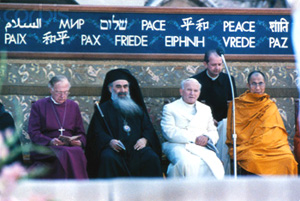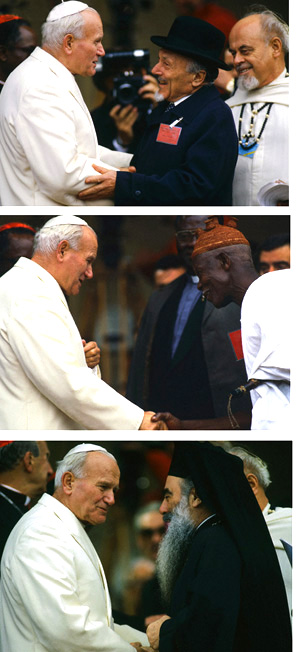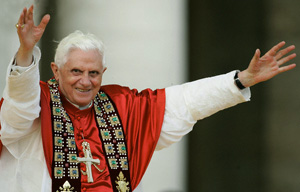 |
Consequences of Vatican II
Assisi and Zarathustra
Lyle J. Arnold, Jr.
The 1986 Assisi "World Day of Prayer for Peace" needs no introduction to Catholics, whether of the progressivist left, the center, or false right. Also those who are militants of the Counter-revolutionary remnant, (the true right), know well what Assisi means.

JPII at the syncretist meeting in Assisi 1986
|
Before that Assisi gathering, John Paul II made the following announcements: "To begin with, I would like to thank all those of the Christian Churches and of the other great religions of the world who have accepted the invitation to go to Assisi on October 27, for a special meeting of prayer for peace, today so fragile and threatened.
"In a few days we shall go to Assisi, representatives of the Catholic Church, of other Christian Churches and ecclesial communities, and of the great religions of the world. ... I issued this invitation to believers of all religions.” (1)
In one of the most shameful scandals of history, in the Church of St. Peter in Assisi, the Dalai Lama and his coreligionists placed a statue of Buddha over the Tabernacle on the altar. A Benedictine priest protested this abomination, and was removed from the scene by the police. (2) We quote the commentary on this incident from Quo Vadis, Petre?:
"The Old Testament relates how one of the kings, Manasses, committed the crime of placing an idol in the Temple of the Lord (4 Kg. 21: 7; 2 Par. 33: 7). God punished this action with the destruction of Jerusalem by the Assyrians (4 Kg. 21: 10-15; Dan. 12: 11). Various Scripture commentators have held that this sacrilege of Manasses gave origin to the expression 'the abomination of the desolation installed itself in the Holy Place,' a phrase employed in Holy Scripture. How can one not compare this event from the Old Testament with the enthronement of a statue of Buddha over the Tabernacle of a Catholic Church in Assisi?” (2)

Assisi 1986: Greeting a Jewish leader, an African shaman, and a schismatic head |
The religious leaders who collaborated with JPII at the 1986 Assisi numbered 130. Their scope of belief included virtually all the errors and heresies known to man, including Animism. There is one especially significant religion that was represented: the religion of the "new" Zarathustra, usually known in English as Zoroaster, the 6th century B.C. Persian prophet of Zoroastrianism.
Zarathustra was a dualist, adhering to the heresy of the eternal struggle between good and evil as a type of war of equals, but not believing in any human form of deity. The 19th century pseudo-philosopher Friedrich Nietzsche adopted Zarathustra's name for his book, Thus Spake Zarathustra.
Nietzsche believed, however, that nothing was good, which, it would seem, is ipso facto a negation of his right to use Zarathustra's name. Nietzsche was not only a mere atheist, but a kind of archetype in the no-man's-land of atheism. Hence the question arises: Since the real Zarathustra believed in good, and Nietzsche did not (he rejected all morality), why did he choose the Persian prophet in his title?
The answer is that he sought to portray a "new" or "different" Zarathustra, one who "turns traditional morality on its head.” He claimed that Zarathustra created the calamitous error of acknowledging morality; therefore his “new” Zarathustra must correct it by “the self-overcoming of morality and the moralist.” He speaks, he proudly claims, as “the first immoralist." (3)
Thus Nietzsche's Zarathustra can say that there is "much that is marvelous in the wicked. ... As for the good and the just, in truth, in you there is much to be laughed at, and especially your fear of what has hitherto been called ‘the devil.’” (4)
What better expression can be found to illustrate the motive of Vatican II, which was to change the mentality of Catholics? Thus, Zarathustra’s assertion that there is "much that is marvelous in the wicked" finds echo in the goal of the Progressivist Church, embodied at Assisi, with its theme of universal salvation.
As Atila Guimaraes notes in an interview about his book Will He Find Faith?, the Council put forward something different from what the Faith teaches: “Vatican II proposed a different thing: We Catholics have ‘our truth,’ but Protestants, Monophysites, Jews, Buddhists, Hinduists, Muslims, Animists, even Masons and Atheists also have ‘their truths.’ Each one would have its own truth that should merge together in order to find the ‘whole truth.’
“This is a relative concept of the faith, and not the absolute concept the Church taught us until the Council. It is a total inversion. Again, we are facing two opposite concepts of the Faith.” (5)

A new invitation for all religions to meet at Assisi |
Just as Zarathustra believed there is "much marvelous in the wicked," the Conciliar Popes believe that no matter what counterfeit deities one follows, said deity will lead him to salvation. Behold the rapport between Zarathustra and Assisi.
Scriptures tells us: "But the things which the heathens sacrifice, they sacrifice to devils and not to God. And I would not that you should be made partakers with devils" (1 Cor 10: 20).
"I am the Lord thy God, who brought thee out of the land of Egypt, out of the house of bondage. Thou shalt not have strange gods before Me. Thou shalt not make to thyself a graven thing, nor the likeness of anything that is in heaven above, or in the earth beneath, nor of those things that are in the waters under the earth. Thou shalt not adore them, nor serve them" (Ex 20:2).
Today, those words are disregarded. Instead we find the Conciliar Church taking a different stance.
"For that old God liveth no more: he is indeed dead... Thus spake Zarathustra." (6)
1. John Paul II, Angelus Address, Sept. 21, 1986.
2. Interview granted to Tommaso Ricci, 30 Dias, November 1990, p. 64, apud "Quo Vadis, Petre?" TIA, 1999, pp. 5-6.
3. Wikipedia, "Nietzsche, Zarathustra - Synopsis"
4. Friedrich Nietzsche, Thus Spake Zarathustra, Wilco Publishing House, 2005, p. 175.
5. John Vennari interviews Atila Sinke Guimaraes on his book Will He Find Faith?," 12
6. Nietzsche, Thus Spake Zarathustra, p. 306.

Posted August 5, 2011

Related Topics of Interest
 Panreligious Meeting in Assisi - 1 Panreligious Meeting in Assisi - 1
 Panreligious Meeting in Assisi - 2 Panreligious Meeting in Assisi - 2
 Assisi 2010 Loses Steam Assisi 2010 Loses Steam
 The Panreligious Encounter in Barcelona The Panreligious Encounter in Barcelona
 Benedict XVI Visits the Cologne Synagogue Benedict XVI Visits the Cologne Synagogue
 Jewish Influence Grows in the Conciliar Church Jewish Influence Grows in the Conciliar Church
 Benedict XVI Practicing Communicatio in Sacris Benedict XVI Practicing Communicatio in Sacris
 Zarathustra and the Council Zarathustra and the Council

Related Works of Interest
|

|
Vatican II | Hot Topics | Home | Books | CDs | Search | Contact Us | Donate

© 2002-
Tradition in Action, Inc. All Rights Reserved
|
 |
|